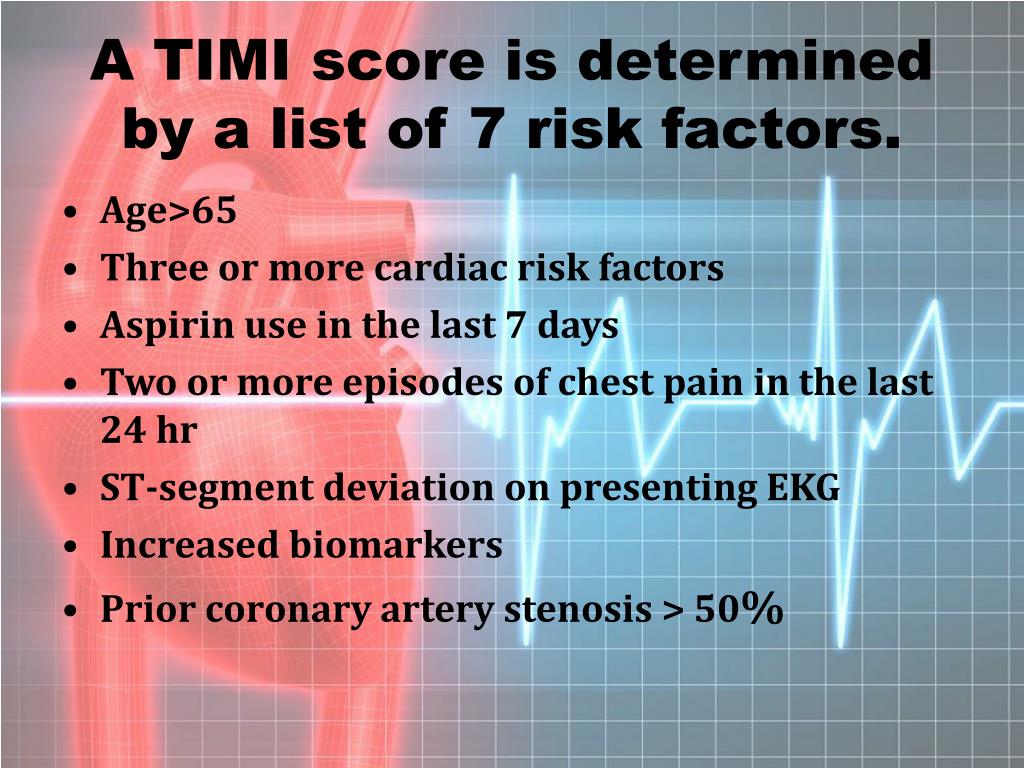

#Timi risk score for nstemi full
First hand diagnosis can be put after ECG, blood cardiac markers, full blood count with elevated WBC, chest X rays and/or echocardiography. The most common symptoms are chest pain which is usually located in the middle of the chest and may radiate towards the arm, shoulder, neck or jaw, difficulty breathing, palpitation due to the nervous system activation and even cardiogenic shock if the AMI is of increased severity. This informs the medical specialists of the severity of the coronary artery occlusion, in most cases, with non ST, only partial, involving less than full thickness of the cardiovascular tissue, therefore the heart muscle is partially infracted.Īmongst the main risk factors there are hypertension, high cholesterol, family and personal history, diabetes mellitus and smoking. Non STEMI is the less severe type of MI, evidenced in the electrocardiogram test without a ST elevation, in this case ST depression. It is still used because of the good determination in chest pain symptomatology but in results of 0 or 1 points where the risk is considered 5% low, other risk models like the ones above should be used to discriminate further and assess whether at this stage is there really necessary to adopt a more aggressive or invasive management of the heart condition. It is the predecessor of troponin testing models such as GRACE or HEART with more up to date risk stratification. The TIMI risk score can also stratify risk in patients with angina and is widely used in chest pain management in clinical stages. In this case, troponin and CK-MB in blood. ■ Positive Cardiac Marker – positive biomarker results, used to evaluate heart function and in the early detection of ACS ischemic events. ■ EKG ST changes ≥ 0.5mm – relevant ST changes in electrocardiogram test ■ Severe angina (≥ 2 episodes in 24 hrs) – more than 2 episodes of severe angina symptomatology in the last 24 hours ■ ASA Use in Past 7 days – frequent aspirin usage in the preceding days to the episode ■ Known CAD (Stenosis ≥ 50%) – increases risk of ischemic accidents ■ ≥ 3 Coronary Artery Disease Risk Factors – family history of CAD, hypertension, hypercholesterolemia, diabetes mellitus or smoking ■ Age ≥ 65 – the higher the age, the higher cardiovascular risk is, above 65 for both genders in similar proportion The factors taken into account are presented below. In order to provide the result, this TIMI risk score for NSTEMI calculator sums the points and delivers a mortality risk percentage. It comprises of 7 factors that are evaluated through a simple questionnaire, each of the answers being given a certain amount of points. It is a tool that differentiates nonSTEMI from STEMI ischemic events. This is a heart disease risk stratification tool allowing medical professionals to assess the adverse outcome and mortality risk in patients suffering from a non ST elevation myocardial infarction or other acute coronary syndrome conditions such as unstable angina. How does this TIMI risk score for NSTEMI calculator work?


 0 kommentar(er)
0 kommentar(er)
